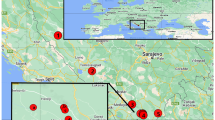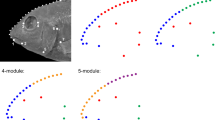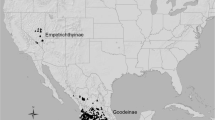Abstract
Gobies and their relatives are significant components of nearshore marine, estuarine, and freshwater fish faunas in both tropical and temperate habitats worldwide. They are remarkable for their ability to adapt to and diversify in a wide range of environments. Among gobiiform clades, species diversities vary widely, ranging from two species in Kurtidae to more than 1,000 species in Gobiidae. There is also great variation in head and body shape and in environmental preferences (fresh, brackish, or marine habitats). In this study, I used a time-calibrated molecular phylogeny, coupled with morphometric and comparative analyses, to examine evolutionary rates of both speciation and morphological diversification among gobiiform lineages. Projection of the phylogeny onto a shape-derived morphospace shows that Gobioidei is morphometrically distinct from its sister taxon Apogonoidei, but that families within Gobioidei overlap in morphospace. Analysis of species diversification rates indicates that three rate shifts have occurred over the evolutionary history of Gobiiformes. Relative to the other lineages, Kurtidae has exhibited a slowdown in speciation, whereas both Apogonidae and Gobiidae + Gobionellidae have experienced an increase in diversification. Comparative analyses show that in Apogonidae and Gobiidae + Gobionellidae, increased speciation is correlated with diminished rates of morphological diversification, differently manifested in either clade and among the various sublineages. The elevation in speciation rates and diminishment in rates of morphological change in both Apogonidae and the clade Gobiidae + Gobionellidae are correlated with shifts to oceanic habitats from freshwater. This pattern is the complement to that seen across the global radiation of acanthomorph fishes in which a decrease in species diversification is associated with an increase in morphological disparity.







Similar content being viewed by others
References
Adams, D. C., Burns, C. M., Kozak, K. H., & Wiens, J. J. (2009). Are rates of species diversification correlated with rates of morphological evolution? Proceedings of the Royal Society of London B, 276, 2729–2738.
Agoretta, A., San Mauro, S., Schliewen, U., Van Tassell, J. L., Kovacic, M., Zardoya, R., & Rüber, L. (2013). Molecular phylogenetics of Gobioidei and phylogenetic placement of European gobies. Molecular Phylogenetics and Evolution, 69(3), 619–633.
Aguilar-Medrano, R., Frederich, B., de Luna, E., & Balart, E. F. (2011). Patterns of morphological evolution of the cephalic region in damselfishes (Perciformes: Pomacentridae) of the Eastern Pacific. Biological Journal of the Linnean Society, 102, 593–613.
Alfaro, M. E., Santini, F., & Brock, C. (2007). Do reefs drive diversification in marine teleosts? Evidence from the pufferfishes and their allies (Order Tetraodontiformes). Evolution, 61(9), 2104–2126.
Alfaro, M. E., Brock, C. D., Banbury, B. L., & Wainwright, P. C. (2009a). Does evolutionary innovation in pharyngeal jaws lead to rapid lineage diversification in labrid fishes? BMC Evolutionary Biology, 9, 255.
Alfaro, M. E., Santini, F., Brock, C., Alamillo, H., Dornburg, A., Rabosky, D. L., Carnevale, G., & Harmon, L. J. (2009b). Nine exceptional radiations plus high turnover explain species diversity in jawed vertebrates. Proceedings of the National Academy of Sciences of the United States of America, 32, 13410–13414.
Bajpai, S., & Kapur, V. V. (2004). Oldest known gobiids from vastan lignite mine (early Eocene), Surat district, Gujarat. Current Science, 87, 433–435.
Bannikov, A. F. (2008). Revision of some Eocene fishes from Bolca, northern Italy, previously classified with the Apogonidae and Enoplosidae (Perciformes). Studi e Ricerche sui giacimenti Terziari di Bolca, XII Miscellanea Paleontologica, 9, 65–76.
Bellwood, D. R., & Wainwright, P. C. (2002). The history and biogeography of fishes on coral reefs. In P. F. Sale (Ed.), Coral reef fishes: Dynamics and diversity in a complex ecosystem (pp. 5–32). USA: Elsevier Science.
Betancur-R, R., Broughton, R. E., Wiley, E. O., Carpenter, K., Lopez, J. A., Li, C., et al. (2013). The tree of life and a new classification of bony fishes. PLoS Currents Tree of Life, 18, 5.
Birdsong, R. S., Murdy, E. O., & Pezold, F. L. (1988). A study of the vertebral column and median fin osteology in gobioid fishes with comments on gobioid relationships. Bulletin of Marine Science, 42(2), 174–214.
Chakrabarty, P., Davis, M. P., & Sparks, J. S. (2012). The first record of a trans-oceanic sister-group relationship between obligate vertebrate troglobites. PLoS One, 7(8), e44083. doi:10.1371/journal.pone.0044083.
Collar, D. C., O’Meara, B. C., Wainwright, P. C., & Near, T. J. (2009). Piscivory limits diversification of feeding morphology in centrarchid fishes. Evolution, 63(6), 1557–1573.
Cooper, W. J., & Westneat, M. W. (2009). Form and function of damselfish skulls: rapid and repeated evolution into a limited number of trophic niches. BMC Evolutionary Biology, 9, 24.
Cowman, P. F., & Bellwood, D. R. (2011). Coral reefs as drivers of cladogenesis: expanding coral reefs, cryptic extinction events, and the development of biodiversity hotspots. Journal of Evolutionary Biology, 24, 2543–2562.
Dornburg, A., Sidlauskas, B., Santini, F., Sorenson, L., Near, T. J., & Alfaro, M. E. (2011). The influence of an innovative locomotor strategy on the phenotypic diversification of triggerfish (Family: Balistidae). Evolution, 65(7), 1912–1926.
Drummond, A. J., Suchard, M. A., Xie, D., & Rambaut, A. (2012). Bayesian phylogenetics with BEAUti and the BEAST 1.7. Molecular Biology and Evolution, 29(8), 1969–1973.
Eastman, J. M., Alfaro, M. E., Joyce, P., Hipp, A. L., & Harmon, L. J. (2011). A novel comparative method for identifying shifts in the rate of character evolution on trees. Evolution, 65(12), 3578–3589.
Eschmeyer, W. N. (ed). (2013). Catalog of Fishes. http://research.calacademy.org/research/ichthyology/catalog/fishcatmain.asp. Accessed June 2013.
Frédérich, B., Sorenson, L., Santini, F., Slater, G. J., & Alfaro, M. E. (2013). Iterative ecological radiation and convergence during the evolutionary history of damselfishes (Pomacentridae). American Naturalist, 181(3), 94–113.
Friedman, M. (2010). Explosive morphological diversification of spiny-finned teleost fishes in the aftermath of the end-Cretaceous extinction. Proceedings of the Royal Society of London B, 277, 1675–1683.
Froese, R., & Pauly, D. (2013) FishBase. http://www.fishbase.org. Accessed June 2013.
Gierl, C., Reichenbacher, B., Gaudant, J., Erpenbeck, D., & Pharisat, A. (2013). An extraordinary gobioid fish fossil from southern France. PLoS One, 8(5), e64117.
Hunt, D. M., Fitzgibbon, J., Slobodyanyuk, S. J., Bowmaker, J. K., & Dulai, K. S. (1997). Molecular evolution of the cottoid fish endemic to Lake Baikal deduced from nuclear DNA evidence. Molecular Phylogenetics and Evolution, 8(3), 415–422.
Jobb, G., von Haeseler, A., & Strimmer, K. (2004). TREEFINDER: a powerful graphical analysis environment for molecular phylogenetics. BMC Evolutionary Biology, 4, 18.
Klingenberg, C. P. (2011). MorphoJ: an integrated software package for geometric morphometrics. Molecular Ecology Research, 11, 353–357.
Leviton, A. E., Gibbs, R. H., Jr., Heal, E., & Dawson, C. E. (1985). Standards in herpetology and ichthyology: Part I. Standard symbolic codes for institutional resource collections in herpetology and ichthyology. Copeia, 1985, 802–832.
Litsios, G., Pellissier, L., Forest, F., Lexer, C., Pearman, P. B., Zimmermann, N. E., & Salamin, N. (2012). Trophic specialization influences the rate of environmental niche evolution in damselfishes (Pomacentridae). Proceedings of the Royal Society of London B, 279, 3662–3669.
Maddison, W. P. & Madison, D. R. (2011). Mesquite: a modular system for evolutionary analysis. Version 2.75. www.mesquiteproject.org. Accessed Jan 2012.
Martin, C. H., & Wainwright, P. C. (2011). Trophic novelty is linked to exceptional rates of morphological diversification in two adaptive radiations of Cyprinodon pupfish. Evolution, 65(8), 2197–2212.
Near, T. J., Dornburg, A., Kuhn, K. L., Eastman, J. T., Pennington, J. N., Patarnello, T., Zane, L., Fernandez, D. A., & Jones, C. D. (2012a). Ancient climate change, antifreeze, and the evolutionary diversification of Antarctic fishes. Proceedings of the National Academy of Sciences of the United States of America, 109(9), 3434–3439.
Near, T. J., Eytan, R. I., Dornburg, A., Kuhn, K. L., Moore, J. A., Davis, M. P., Wainwright, P. C., Friedman, M., & Smith, W. L. (2012b). Resolution of ray-finned fish diversity and timing of diversification. Proceedings of the National Academy of Sciences of the United States of America, 109(34), 13698–13703.
Near, T. J., Dornburg, A., Eytan, R. I., Keck, B. P., Smith, W. L., Kuhn, K. L., et al. (2013). Phylogeny and tempo of diversification in the superradiation of spiny-rayed fishes. Proceedings of the National Academy of Sciences of the United States of America, 110(31), 12738–12743.
Nelson, J. S. (2006). Fishes of the world (4th ed.). New Jersey: Wiley.
O’Meara, B. C., Ane, C., Sanderson, M. J., & Wainwright, P. C. (2006). Testing for different rates of continuous trait evolution using likelihood. Evolution, 60(5), 922–933.
Pothoff, T. (1984). Clearing and staining techniques. In H. G. Moser (Ed.), Ontogeny and systematics of fishes (Spec. Pub. ASIH No. 1, pp. 35–37). Lawrence: Allen.
Price, S. A., Wainwright, P. C., Bellwood, D. R., Kazancioglu, E., Collar, D. C., & Near, T. J. (2010). Functional innovations and morphological diversification in parrotfish. Evolution, 64(10), 3057–3068.
Price, S. A., Holzman, R., Near, T. J., & Wainwright, P. C. (2011). Coral reefs promote the evolution of morphological diversity and ecological novelty in labrid fishes. Ecology Letters, 14, 462–469.
R Development Core Team (2011). R: a Language and Environment for Statistical Computing. http://www.r-project.org. Accessed Mar 2012.
Rabosky, D. L., & Adams, D. C. (2012). Rates of morphological evolution are correlated with species richness in salamanders. Evolution, 66(6), 1807–1818.
Rabosky, D. L., Santini, F., Eastman, J., Smith, S. A., Sidlauskas, B., Chang, J., & Alfaro, M. E. (2013). Rates of speciation and morphological evolution are correlated across the largest vertebrate radiation. Nature Communications, 4, 1958.
Reichenbacher, B., & Schwarz, J. (1997). Charophyten und Otolithen aus den Cyrenen-Schichten des nördlichen Alpenvorlandes. Paläontologische Zeitschrift, 71, 173–188.
Renema, W., Bellwood, D. R., Braga, J. C., Bromfield, K., Hall, R., Johnson, K. G., Lunt, P., Meyer, C. P., McMonagle, L. B., Morley, R. J., O’Dea, A., Todd, J. A., Wesselingh, F. P., Wilson, M. E. J., & Pandolfi, J. M. (2008). Hopping hotspots: global shifts in marine biodiversity. Science, 321, 654–657.
Rohlf, F. J. (2010). TpsDig2 Software package. http://life.bio.sunysb.edu/morph. Accessed Mar 2010.
Sallan, L. C., & Friedman, M. (2012). Heads or tails: staged diversification in vertebrate evolutionary radiations. Proceedings of the Royal Society of London B, 279, 2025–2032.
Salzburger, W. S., Meyer, A., Baric, S., Verheyen, E., & Sturmbauer, C. (2002). Phylogeny of the Lake Tanganyika Cichlid species flock and its relationship to the Central and East African haplochromine cichlid fish faunas. Systematic Biology, 51(1), 113–135.
Santini, F., Harmon, L. J., Carnevale, G., & Alfaro, M. E. (2009). Did genome duplication drive the origin of teleosts? A comparative study of diversification in ray-finned fishes. BMC Evolutionary Biology, 9, 194.
Santini, F., Nguyen, N. T. T., Sorenson, L., Waltzek, T. B., Lynch Alfaro, J. W., Eastman, J. M., & Alfaro, M. E. (2013). Do habitat shifts drive diversification in teleost fishes? An example from the pufferfishes (Tetraodontidae). Journal of Evolutionary Biology, 26(5), 1003–1018.
Sidlauskas, B. (2007). Testing for unequal rates of morphological diversification in the absence of a detailed phylogeny: a case study from characiform fishes. Evolution, 61(2), 299–316.
Sidlauskas, B. (2008). Continuous and arrested morphological diversification in sister clades of characiform fishes: a phylomorphospace approach. Evolution, 62(12), 3135–3156.
Stone, J. R. (2003). Mapping cladograms into morphospaces. Acta Zoologica, 84, 63–68.
Tallebois, L., Castalin, M., Lord, C., Chabarria, R., Dettai, A., & Keith, P. (2013). New Sicydiinae phylogeny (Teleostei: Gobioidei) inferred from mitochondrial and nuclear genes: insights on systematics and ancestral areas. Molecular Phylogenetics and Evolution, 70, 260–271.
Thacker, C. E. (2009). Phylogeny of Gobioidei and placement within Acanthomorpha, with a new classification and investigation of diversification and character evolution. Copeia, 2009, 93–104.
Thacker, C. E. (2013). Phylogenetic placement of the European sand gobies in Gobionellidae and characterization of gobionellid lineages (Gobiiformes: Gobioidei). Zootaxa, 3619(3), 369–382.
Thacker, C. E., & Roje, D. M. (2009). Phylogeny of cardinalfishes (Teleostei: Gobiiformes: Apogonidae) and the evolution of visceral bioluminescence. Molecular Phylogenetics and Evolution, 52, 735–745.
Thacker, C. E., & Roje, D. M. (2011). Phylogeny of Gobiidae and identification of gobiid lineages. Systematics and Biodiversity, 9(4), 329–347.
Tornabene, L., Chen, Y., & Pezold, F. (2013). Gobies are deeply divided: phylogenetic evidence from nuclear DNA (Teleostei: Gobioidei: Gobiidae). Systematics and Biodiversity, 11, 1–17.
Wood, R. (1999). Reef evolution. Oxford: Oxford University.
Yoder, J. B., Clancey, E., Des Roches, S., Eastman, J. M., Gentry, L., Godsoe, W., Hagey, T. J., Jochimsen, D., Oswald, B. P., Robertson, J., Sarver, B. A. J., Schenk, J. J., Spear, S. F., & Harmon, L. J. (2010). Ecological opportunity and the origin of adaptive radiations. Journal of Evolutionary Biology, 23, 1581–1596.
Acknowledgments
This work was supported by the National Science Foundation (NSF DEB 0108416) and by grants from the W. M. Keck and R. M. Parsons Foundations in support of the program in Molecular Systematics and Evolution at the Natural History Museum of Los Angeles County. I am grateful to P. Chakrabarty, W. L. Smith, and B. Sidlauskas for their extremely generous assistance with and advice on morphometrics and analyses. Helpful advice and assistance with the MEDUSA analyses were provided by M. Alfaro and P. Gilbert. I also thank P. Chakrabarty and J. Sparks (AMNH), M. McGrouther (AMS), S. Raredon (USNM), K. Swagel (FMNH), and J. Seigel (LACM) for providing specimens and radiographs. H. Larson generously provided specimens of Kurtus gulliveri on exchange to LACM, and D. Geiger expertly prepared Figs. 3, 4, 6, and 7.
Author information
Authors and Affiliations
Corresponding author
Rights and permissions
About this article
Cite this article
Thacker, C.E. Species and shape diversification are inversely correlated among gobies and cardinalfishes (Teleostei: Gobiiformes). Org Divers Evol 14, 419–436 (2014). https://doi.org/10.1007/s13127-014-0175-5
Received:
Accepted:
Published:
Issue Date:
DOI: https://doi.org/10.1007/s13127-014-0175-5




